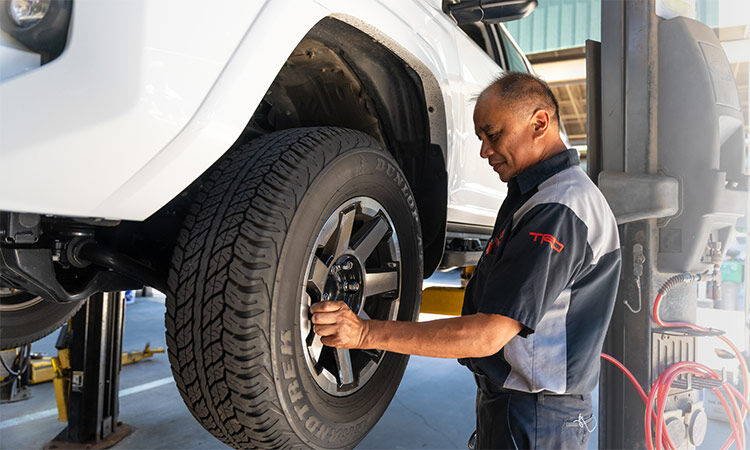Obtain Road-Ready with Professional GMC Tires Service at Morris Tires
Obtain Road-Ready with Professional GMC Tires Service at Morris Tires
Blog Article
Tire Service: The Impact of Weather Problems
When it pertains to guaranteeing optimal efficiency and security when driving, recognizing the influence of weather on tire solution is vital. From scorching warmth to icy roadways, each weather condition component can substantially influence tire performance and overall driving experience. By diving into the results of varying climate condition on tires, chauffeurs can get useful understandings that might boost their vehicle's efficiency and longevity. In this conversation, we will check out the intricate connection between weather and tire service, losing light on the relevance of weather-specific tire maintenance practices and factors to consider.
Warmth and Tire Performance
When subjected to high temperature levels, tires experience modifications in performance that can substantially affect vehicle security and handling. The heat created from long term driving or heat problems causes the tire rubber to soften, causing minimized step life and boosted wear. As the rubber comes to be softer, the tire's grasp on the roadway diminishes, impacting stopping ranges and general traction. In extreme instances, excessive heat can also cause tire blowouts, presenting an extreme safety threat to the lorry and its passengers.

Winter Effects
Cold climate conditions can have a considerable impact on tire efficiency and safety and security. In chilly climate, tires may also lose air stress a lot more quickly, which can impact managing and fuel effectiveness.
To reduce the impacts of cool weather condition on tires, it is critical to on a regular basis inspect tire pressure and inflate them to the supplier's suggested degrees. Utilizing wintertime or all-season tires made for cool weather condition problems can also boost traction and hold on icy or snowy roads. Correct tire upkeep, including normal examinations for wear and damages, comes to be a lot more crucial during chillier months to make certain optimal efficiency and security.
Rainy Issues Impact
Throughout stormy conditions, tire efficiency and safety and security can be considerably influenced by the damp roadway surfaces and decreased visibility. The tread pattern of tires plays a crucial duty in maintaining traction on damp roads. Tires with damaged treads are a lot more vulnerable to hydroplaning, where a layer of water builds up between the tire and the road surface area, bring about loss of grip. To fight this, motorists should on a regular basis inspect their tires for appropriate walk depth and take into consideration purchasing tires specifically created for wet problems.
In addition, wet weather can also decrease presence, making it testing for motorists here to see the roadway in advance clearly (GMC Tire Service). In such problems, it is vital to readjust driving speeds accordingly and preserve a safe complying with range to enable for abrupt quits. Properly inflated tires can also aid in keeping control on damp roadways by offering much better handling and grasp
Snow and Tire Safety And Security
When driving in snowy conditions, having the ideal tires can make a substantial difference in safety and performance. Winter months tires are created with special rubber compounds and tread patterns to give better grip on snow and ice compared to all-season tires.
It is essential to follow producer guidelines when using and mounting tire chains to stop damage to the tires and automobile. By choosing the appropriate tires, keeping proper rising cost of living, and taking into consideration additional traction aids like tire chains, vehicle drivers can boost their safety when navigating snow-covered roadways.
Weather-Related Tire Maintenance
When confronted with different weather, appropriate tire maintenance becomes a vital element of vehicle security and efficiency. Weather-related tire maintenance includes a variety of practices targeted at making certain ideal tire feature and long life in different climate circumstances. One vital element of weather-related tire upkeep is tire stress regulation. Fluctuating temperature levels can trigger tire stress to vary, impacting grip and gas performance. Consistently changing and checking tire pressure according to producer referrals is necessary for safe driving in transforming weather. In addition, tire step depth plays a considerable function in taking care of different weather aspects. Tires with appropriate walk depth provide better hold on wet or icy roadways, lowering the danger of skidding or hydroplaning. Inspecting tire step regularly and replacing tires when step wear reaches a certain depth is essential for preserving grip and security in unfavorable weather. By prioritizing weather-related tire maintenance, chauffeurs can boost safety, improve automobile performance, and extend the life-span of their tires.
Final Thought
In final thought, weather condition problems have a considerable influence on tire performance and safety. From heat impacting tire pressure and use to cool weather minimizing grip, it is important to best site take into consideration the weather condition when preserving and using tires.
In this discussion, we will my blog certainly check out the elaborate relationship between weather condition problems and tire solution, losing light on the significance of weather-specific tire upkeep techniques and considerations.

Report this page